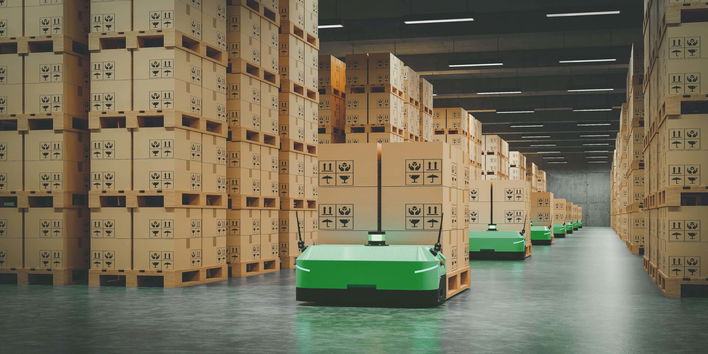The industrial internet of things (IIoT) has been gaining momentum in recent years as more and more firms seek to take advantage of connected devices and data to improve efficiency and optimize their processes.
The Industrial Internet of Things (IIoT) market size is projected to reach $78400 million by 2028, from $57040 million in 2021, at a CAGR of 4.2% during 2022-2028. - Proficient Market Insights
When talking from the industry viewpoint, opting for digital transformation is becoming a business priority for many organizations. Most companies that successfully integrate their business process and technological stacks reap the benefits of IIoT.
There are digital technologies that can boost your business’s operational efficiency and enhance its overall performance. For modern business owners and leaders, one such major area of investment is the industrial internet of things.
This technology can help with
- Reduction in downtimes
- Implementation of new business models
- Customer experience enhancement
What is IIoT (Industrial Internet of Things)?
Industrial IoT, which is also called the industrial internet, is a mixture of
- business-critical assets
- advanced prescriptive and predictive analysis
- modern industrial workers
It refers to the interconnected mapping of industrial assets and sensors over a wireless network.
Why should any industry or organization opt for IIoT?
The Industrial Internet of Things (IIoT) market was worth approximately $77.3 billion in 2020 and is expected to grow to $110.6 billion by 2025. - PRN Newswire
Connected devices are bound to create bulk datasets. These datasets hold valuable information that can help businesses grow their revenue with important insight.

How? Well, IIoT is a network of multiple industrial devices that are connected by communications technologies. These connected digital systems are tasked with
- Monitoring
- Collecting
- Exchanging
- Analyzing
- Delivering valuable insights
Applying artificial intelligence, a wider field of study that encompasses machine learning, in IoT data is already delivering proven benefits for firms.
According to IDC, the most common use cases for machine learning and IoT data will be predictive maintenance, followed by analyzing CCTV surveillance, smart home applications, in-store ‘contextualized marketing’, and intelligent transportation systems.
Solutions like Octave, an edge-to-cloud solution that connects industrial assets, are simplifying IIoT implementation. It has enabled businesses to break the wall between themselves and the early adopters of the technology.
When talking from the industry viewpoint, opting for digital transformation is becoming a business priority for many organizations. Most companies that successfully integrate their business process and technological stacks reap the benefits of IIoT.
There are digital technologies that can boost your business’s operational efficiency and enhance its overall performance. For modern business owners and leaders, one such central investment area is the industrial internet of things.
This technology can help with:
- Reduction in downtimes
- Implementation of new business models
- Customer experience enhancement
Implementing artificial intelligence, an extension of machine learning, in IoT data already delivers proven benefits for firms.
ThyssenKrupp is one of the earliest firms to pair IoT sensor data with machine learning models. The company runs 1.1 million elevators worldwide. The company has fed many data collected by internet-connected sensors into machine-learning trained models and has gained expertise in predictive maintenance.
ThyssenKrupp's predictive maintenance solutions offer real-time information on the status of elevators, as well as predictions on which ones will fail and when. This enables ThyssenKrupp to prioritize repairs where needed and cut down on elevator outage costs.
Industrial IoT trends for 2022 and beyond
Research shows there will be 35 billion smart devices online by 2021, and that number will rise to 75 billion by 2025.
Industry 4.0 beyond 2022 and the learning from the shortcoming unearthed by the pandemic will shape the paths of many companies.
In this section, we will list down the trends that business owners must consider while creating plans for their upcoming financial sessions.
Let’s delve deep into the IIoT trends essential to business owners for 2022 and beyond.
Connected devices are bound to create bulk datasets. These datasets hold valuable information that can help companies to grow their revenue with critical insights. Businesses can use these connected digital systems for:
- Monitoring data
- Collecting information
- Exchanging data
- Analyzing the data sets
- Delivering valuable insights
And with the COVID-19 pandemic accelerating the digitization of industry, there's no doubt that IIoT is here to stay.
But what exactly does the future hold for IIoT? What trends will be most popular this year? Here are a few IIoT trends that businesses should keep an eye on in 2022:
1. Increased adoption of edge computing
Edge computing is a critical component of IIoT, as it enables data processing closer to the source (i.e., the edge devices). This is important for IIoT applications because it reduces latency and improves data security.
We expect to see increased adoption of edge computing in 2022 as more businesses realize the benefits it can provide. We also hope to see more edge computing platforms and solutions emerge, making it easier for companies to get started with this technology.
2. More focus on data security
Data security is a significant concern for businesses when it comes to IIoT. After all, connected devices collect sensitive data about operations, which could be compromised if IIoT systems are not adequately secured.
Businesses will emphasize more on data security in 2022 as they look to protect their IIoT investment. We also expect to see more IIoT platforms and solution providers offering built-in security features, making it easier for businesses to secure their systems.
3. Greater use of AI and machine learning
AI and machine learning are powerful tools that can be used to improve IIoT applications. Businesses can use these technologies to optimize operations, predict maintenance needs, and much more.
We will see even greater AI and machine learning use within IIoT applications in 2022. These technologies will provide more value for businesses implementing them as they become more advanced.
A large data chunk needs to be pre-processed and normalized before being used for training machine learning algorithms. 2021 has seen a more unsupervised approach to training AI; in 2022, the target will be to analyze data from a monitored device sent to the AI algorithm without human interference.
This can be achieved via an advanced self-learning ML algorithm. With a pre-determined threshold, the ML algorithm detects anomalies in the data patterns. An algorithm has been set for reading thermal, vibration, and electrical circuitry data from an electric motor. When the engine generates patterns outside the standard threshold, the ML algorithm will flag maintenance.
Want to build your own AI solution? Read more about it by clicking here.
4. Predictive maintenance
Unplanned downtime for manufacturing equipment can disrupt or sometimes wholly halt operations. It cuts the bottom line, the supply chain is disrupted, meeting deadlines becomes more arduous, and it threatens the overall equipment health.
Many manufacturers have developed predictive maintenance strategies to combat this problem; some have gotten even further to installing IIoT-enabled predictive maintenance technologies.
Many valuable technologies, from temperature sensors to robotics, enable manufacturers to identify potential problems, schedule device servicing, and maintain streamlined operations.
5. Continued growth of the IoT ecosystem
The IoT ecosystem constantly evolves as new devices, platforms, and solutions are introduced. This can make it difficult for businesses to keep up with the latest trends.
In 2022, we expect the IoT ecosystem to continue growing at a rapid pace. This means businesses must be diligent in keeping up with the latest trends and technologies to stay ahead of the curve.
These are just a few IIoT trends we expect to see in the coming year. By staying up-to-date on these trends, businesses can ensure that they are well-positioned to take advantage of the opportunities that IIoT provides.
6. Manufacturing, healthcare, and utility sectors will contribute to IIoT growth
The success of Google Nest smart thermostat, Amazon Echo smart speaker, and Ring smart doorbell says a lot about the success of IoT in the consumer sector. For 2022 and beyond, IoT will touch many other industrial sectors, such as:
- Manufacturing
- Healthcare
- Utility
The latest IIoT solutions allow Original Equipment Manufacturers (OEMs) and other manufacturing companies to plug their equipment with IIoT and start acting on the data in real-time. This lowers the tie time-to-value of IIoT applications and helps businesses get faster ROIs.
The pandemic helped the medical industry realize the need for providing connected healthcare services. Internet-based telemedicine solutions were a big hit during the Covid-19 pandemic and significantly reduced costs for both medical providers and patients.
With the Internet of Medical Things (IoMT), healthcare providers can extend their services to patients with the help of monitors, scanners, and other connected medical devices.
They can readily diagnose patients and remotely monitor and assist them. These connected devices can work within a set parameter and generate the medical treatment and diagnostic documents independently, saving a lot of time.
Utility industries will also start ramping up their IIoT application in 2022. IIoT application in the utility industry can help with:
- Operational efficiency
- Enhancing customer engagement
- Application sustainability and reliability
Application of IIoT in the utility industry will help with:
- Performing remote diagnostics
- Predictive maintenance of grid infrastructure
- Reduction of equipment downtime
- Lowering the maintenance cost
- Collection and analysis of wind and solar data
- Balancing the energy demand and supply grid
If you want to learn more about the latest trends in the manufacturing and supply chain industry, this informational guide compiled by our team of professionals will come in handy for you.
The guide carefully outlines the various industry use-cases that can guide executives to anticipate market changes, fill the technological gaps in their supply chain and manufacturing processes, and plug in the growth factor for faster monetization.
7. Remote monitoring
IIoT sensors are usually relied upon for accurate location monitoring and the tracking of the state of hardware assets. These IIoT software applications are critical when the hardware assets and heavy industrial equipment are highly valued and require active monitoring.
With IIoT sensors connected to the equipment, they provide real-time data on location, equipment health, remaining life, and other functional parameters, which are then updated in the tracking software for the management to view from anywhere.
They can keep an eye on this data from anywhere and only take action when necessary.
8. Functional safety
Manufacturing plants have processes and equipment that require proper training and care.
To improve the workers’ health and safety and more streamlined processes, the manufacturing industry has developed standardized practices that every worker should adhere to.
IIOT functional safety technologies are being implemented all over the production plants, and these smart technologies alert workers to take precautions to stay safe and healthy.
9. Self-training machine learning
A large data chunk needs to be pre-processed and normalized before being used for training machine learning algorithms. This process creates a lot of roadblocks in the implementation of machine learning.
2021 has seen a more unsupervised approach to training AI. This approach sends data from a monitored device to the AI algorithm without human interference.
With the help of a pre-determined threshold, the ML algorithm detects anomalies in the data patterns. For instance, an algorithm has been set for reading thermal, vibration, and electrical circuitry data from an electric motor.
When the motor starts generating patterns outside the standard threshold, the ML algorithm will immediately flag maintenance for the machinery.
10. IIoT data analytics
IIoT data analytics will have significantly different data management paradigms than IoT data analytics. By 2025 over 180 trillion gigabytes of data will be created worldwide every year, and IIoT-enabled industries will largely contribute to this rise in data volume.
With the increase in the size and form of data created by IoT devices and end-points, businesses will capitalize on this using AI trends and ML innovations. IEEE is working on 802.11ax, which uses 2.4Ghz and 5.0Ghz wireless frequencies simultaneously.
These frequencies provide faster access points to the IoT devices. They also boost the capacity and bandwidth speed while making them energy efficient for businesses.
Application of IIoT in the utility industry will help with
- Performing remote diagnostics
- Predictive maintenance of grid infrastructure
- Reduction of equipment downtime
- Lowering the maintenance cost
- Collection and analysis of wind and solar data
- Balancing the energy demand and supply grid
Why and how much does Industrial IoT matter to industries?
The industrial internet of things is a connected network of machines and devices in oil and gas, power, manufacturing, and healthcare. Any critical system failure or downtime can lead to high-risk situations.
As more industries are relying on connecting their business-critical machines, they realize this connected network is capable of enhancing and generating better revenue.
Just imagine a situation where you can use advanced analytics to predict crucial events. Asset Performance Management (APM) solutions help businesses increase their asset reliability while
- Optimizing maintenance costs
- Mitigating operational risks
- Reducing total cost of ownership (TCO)
By using Manufacturing Execution Systems (MES), businesses can use real-time visibility for recovering production capacity driving greater efficiency by using factory insights.
Are you looking to simplify yet accelerate your industrial internet of things journey?
Industrial software can provide breakthrough results by empowering modern industrial workers. You can get rid of the toughest challenges when you have AI-based industrial solutions. What you require is the right digital partner who can turn your vision into reality!
“There will be 75 billion IoT devices worldwide by 2025, and many of these devices will provide data-driven prognostic and diagnostic information” - safeatlast
Most organizations successfully connect their business processes, and technological foundations benefit from IIoT. Industrial software can provide breakthrough results by empowering modern industrial workers.
We're ready to take care of your IIoT implementation. By empowering modern industrial personnel with sophisticated data analytics, Industrial IoT may provide revolutionary outcomes.
You can overcome the most challenging obstacles with AI-enabled industrial IoT solutions.
If you are searching for a suitable digital partner to achieve your industrial IoT dream, then you are at the right place.
At Rapidops, we have assisted various businesses in discovering hidden digital opportunities by disrupting their legacy systems and merging them with the necessary digital technologies.
Our well-learned and smart working professionals have always sought new methods of improving business efficiency. We built a machine learning IoT platform that gathers, organizes, and hypercharges machine logs to provide faster actionable insights.
What’s Inside
- What is IIoT (Industrial Internet of Things)?
- Why should any industry or organization opt for IIoT?
- Industrial IoT trends for 2022 and beyond
- 1. Increased adoption of edge computing
- 2. More focus on data security
- 3. Greater use of AI and machine learning
- 4. Predictive maintenance
- 5. Continued growth of the IoT ecosystem
- 6. Manufacturing, healthcare, and utility sectors will contribute to IIoT growth
- 7. Remote monitoring
- 8. Functional safety
- 9. Self-training machine learning
- 10. IIoT data analytics
- Why and how much does Industrial IoT matter to industries?
- Are you looking to simplify yet accelerate your industrial internet of things journey?




